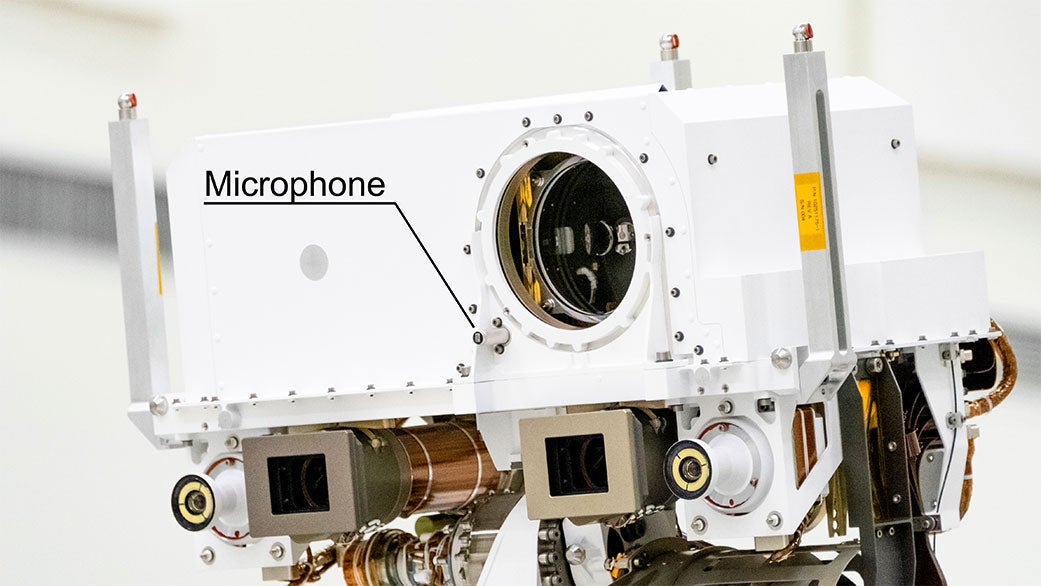Your support helps us to tell the story
From reproductive rights to climate change to Big Tech, The Independent is on the ground when the story is developing. Whether it's investigating the financials of Elon Musk's pro-Trump PAC or producing our latest documentary, 'The A Word', which shines a light on the American women fighting for reproductive rights, we know how important it is to parse out the facts from the messaging.
At such a critical moment in US history, we need reporters on the ground. Your donation allows us to keep sending journalists to speak to both sides of the story.
The Independent is trusted by Americans across the entire political spectrum. And unlike many other quality news outlets, we choose not to lock Americans out of our reporting and analysis with paywalls. We believe quality journalism should be available to everyone, paid for by those who can afford it.
Your support makes all the difference.Nasa’s Perseverance rover has recorded five hours of sounds from Mars and scientists said it made them feel as if they were “right there on the surface.”
The rover now has the unique distinction of becoming the first spacecraft to record the sounds of the Red Planet through dedicated microphones, according to a press release issued by the space agency on Monday.
“Sound on Mars carries much farther than we thought. It shows you just how important it is to do field science,” said Nina Lanza, a SuperCam scientist working with mic data at the Los Alamos National Laboratory (LANL) in New Mexico.
“We’ve all seen these beautiful images that we get from Mars but having sound to be able to add to those images, it makes me feel like I’m almost right there on the surface,” said Dr Lanza in a video released by Nasa.
The sounds recorded by the rover – deep clicking noises from a laser, buzzing rotors, rover wheels crunching gravel and deep bass drops – might not be a medley for the average listener.
For scientists, however, these sounds hold significant value. They are already helping them know more about the planet’s atmosphere, how sound travels across the planet and are lending a hand in spacecraft maintenance as well.
The Perseverance rover has two “commercially available, off-the-shelf” mics embedded on it. One of them is on the side of the rover’s chassis, while the other is perched on its mast as a compliment to the rover’s SuperCam instrument that shoots laser beams on rocks to help scientists analyse them.
The SuperCam instrument and mic is provided by LANL and a consortium of French research laboratories under the auspices of the Centre National d’Etudes Spatiales (CNES), while the chassis mic is from Nasa’s Jet Propulsion Laboratory in southern California.

The SuperCam zaps Mars’s rocks and analyses the resulting vapour from a camera on top of Perseverance.
“Because the laser pulses up to hundreds of times per target, opportunities to capture the sound of those zaps quickly add up: the microphone has already recorded more than 25,000 laser shots,” said Nasa in the press release.
The mic’s location helps it monitor “microturbulence” or minute shifts in the air, helping scientists learn more about the changes in the planet’s atmosphere.
They also compliment the rover’s wind sensors that are a part of its atmospheric tools called the Mars Environmental Dynamics Analyzer (MEDA).
Meda’s sensors rapidly monitor the planet’s wind speed, pressure and temperature, one or two times per second for up to two hours at a time, with the SuperCam mic providing similar information at a rate of 20,000 times per second in several minutes, said the press release.
This helps scientists learn how sound is propagated on the Red Planet, whose atmosphere is less dense than Earth’s. Scientists said they knew, because of this fact, that it would be tougher to hear high-pitch sounds.
But they were surprised when the mic picked up tiny robotic helicopter Ingenuity’s buzzing rotors 262 feet away on its 30 April flight.
Because of this, the scientists were able to eliminate two models out of the three that anticipated how sound travels on Mars.
The sounds will also be used by the scientists to monitor the health of their instruments on the planet and with maintaining the spacecraft.
The chassis mic listens to Perseverance’s wheels and other internal systems. The space agency said the mic will help them monitor the spacecraft’s performance “the way mechanics might listen to a car engine”.

Join our commenting forum
Join thought-provoking conversations, follow other Independent readers and see their replies
Comments